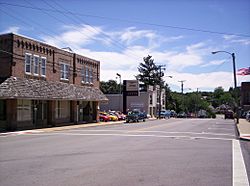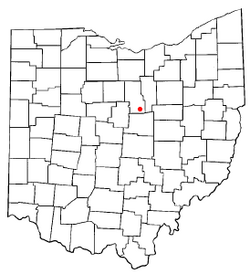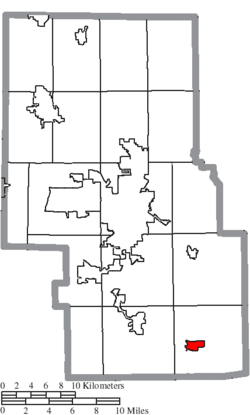Butler, Ohio facts for kids
Quick facts for kids
Butler, Ohio
|
|
|---|---|
|
Village
|
|

Downtown Butler on Main Street in 2008
|
|

Location of Butler
|
|

Location of Butler in Richland County, Ohio
|
|
| Country | United States |
| State | Ohio |
| County | Richland |
| Area | |
| • Total | 1.30 sq mi (3.37 km2) |
| • Land | 1.29 sq mi (3.34 km2) |
| • Water | 0.01 sq mi (0.03 km2) |
| Elevation | 1,073 ft (327 m) |
| Population
(2020)
|
|
| • Total | 941 |
| • Estimate
(2023)
|
938 |
| • Density | 729.46/sq mi (281.56/km2) |
| Time zone | UTC-5 (Eastern (EST)) |
| • Summer (DST) | UTC-4 (EDT) |
| ZIP Code |
44822
|
| Area code(s) | 419 |
| FIPS code | 39-10632 |
| GNIS feature ID | 2397511 |
Butler is a small village in Richland County, Ohio. It is part of the larger Mansfield area. In 2020, about 941 people lived there.
Contents
Discovering Butler's Past
Native American Roots and Early Settlers
Before Butler became a village, it was a hunting ground for the Delaware Indians. They called it Helltown because it had lots of wild game and good farmland.
The first European settlers arrived in the area around 1808. However, the exact spot where Butler now stands was settled about 10 years later. Joseph Craig was the first white settler in the Butler area. He received a land grant from President James Monroe in 1823.
In 1809, Samuel Lewis traveled through the region. He helped organize the Richland area into townships in 1813. This is how Butler became part of Worthington Township.
How Butler Got Its Name
The village was first planned on January 12, 1848, by Daniel Spohn. It was initially called "Independence." People also nicknamed it "Spohntown" or "Squeelgut." The name Independence was chosen to show defiance towards the nearby village of Bellville, which wasn't very friendly.
The name changed to Butler in the 1870s. It was named after General William Butler, a hero from the Mexican War. In 1891, the post office name was also changed to Butler to match the village.
Thomas B. Andrews, born in 1807, arrived in the village in 1833. He and Daniel Spohn helped lay out the town. Andrews was also Butler's first Postmaster. He first ran the post office from his house and later moved it to a warehouse.
First Businesses and Community Life
The first store in Butler was opened by William Lamley. He sold groceries and other goods. Later, he built a larger building and started the first hotel, which Joseph Geary managed. Another hotel was built by David Teeter.
John Diltz, a carpenter, built the next house. Daniel Garber opened a shoe-shop on Main Street. William Clapper also built a place and offered lodging.
Gen. G. A. Jones came to Butler and opened a warehouse and a store. He dealt in farm products. In 1856, I. W. Pearce bought Jones's warehouse. Pearce ran the business and also worked as a railroad agent. He eventually ran the main store and handled banking for the town.
Butler became known as a "temperance town." This means it did not allow saloons. This policy came about after an incident involving the Bowersox Saloon.
Schools and Railroads
The first schoolhouse was a small A-frame building south of town. In 1868, a new, two-story school building was built. It had two teachers and taught about 100 students.
The B&O railroad was very important for Butler's growth. It was built in 1853. This railroad was unique because it entered and left the town from the same direction (west). In 1872, there was a train accident where two passenger trains crashed, sadly killing eight people and injuring 40 others.
In 1877, Butler officially became an incorporated village. The first mayor was J. M. McLaughlin. George W. McBee was the second mayor.
By that time, Butler had several stores, two churches, and one hotel. The population was about 400 people.
Where is Butler Located?
Butler is located along the Clear Fork of the Mohican River.
According to the U.S. Census Bureau, the village covers about 1.15 square miles (3.37 square kilometers). Most of this area is land, with a small part being water.
Who Lives in Butler?
| Historical population | |||
|---|---|---|---|
| Census | Pop. | %± | |
| 1880 | 394 | — | |
| 1890 | 266 | −32.5% | |
| 1900 | 567 | 113.2% | |
| 1910 | 730 | 28.7% | |
| 1920 | 622 | −14.8% | |
| 1930 | 634 | 1.9% | |
| 1940 | 695 | 9.6% | |
| 1950 | 833 | 19.9% | |
| 1960 | 976 | 17.2% | |
| 1970 | 1,052 | 7.8% | |
| 1980 | 991 | −5.8% | |
| 1990 | 968 | −2.3% | |
| 2000 | 921 | −4.9% | |
| 2010 | 933 | 1.3% | |
| 2020 | 941 | 0.9% | |
| 2023 (est.) | 938 | 0.5% | |
| Sources: | |||
Population in 2010
In 2010, there were 933 people living in Butler. They lived in 362 households, with 259 of those being families. The village had about 818 people per square mile.
Most of the people living in Butler were White (98.3%). A small number were African American, Native American, or Asian. About 1.5% of the population was Hispanic or Latino.
About 36.5% of households had children under 18. Many households (53.3%) were married couples. About 28.5% of households were not families.
The average age in the village was 37.2 years old. About 26.8% of residents were under 18. About 15% were 65 years or older. The population was almost evenly split between males (48.3%) and females (51.7%).
Learning and Education
Butler is part of the Clear Fork Valley Local School District. Butler Elementary School is located right in the village. Clear Fork Middle School and Clear Fork High School are just outside Bellville.
Butler also has a public library. It is a branch of the Mansfield–Richland County Public Library.
Notable People from Butler
- Jim Wilson was a banker and a member of the Los Angeles City Council. He was born in Butler.
Images for kids
See also
 In Spanish: Butler (Ohio) para niños
In Spanish: Butler (Ohio) para niños


